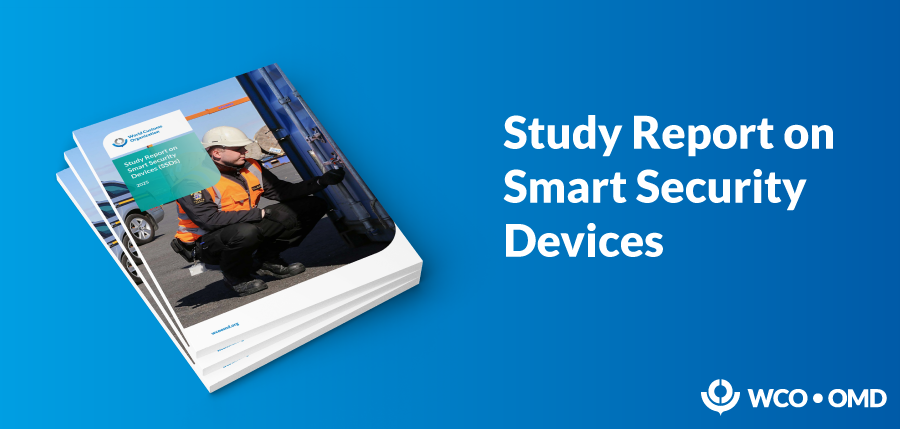
WCO reports on Smart Security Devices finds significant benefits for trade operators and enforcement authorities if technical and regulatory hurdles are overcome
BRUSSELS : The World Customs Organization (WCO) has published a major report into the rising impact of Smart Security Devices (SSDs) on logistics and Customs procedures. The Report explores the growing role of connected devices, such as smart locks, track-and-trace sensors, and smart containers, in modernizing the supervision of cross-border cargo. Although new technologies contribute to trade facilitation, supply chain security and integrity, the WCO’s Report identifies several critical challenges. These include data security, legal frameworks, and interoperability, all of which must be addressed through international cooperation to fully realize the benefits of SSDs.
SSDs – Securing cargo and strengthening the global supply chain
WCO’s Study Report on SSDs offers a detailed analysis of the potential far-reaching impact of these technologies into everyday Customs and trade operations, through supporting Customs risk management, streamlining cargo clearance procedures, and the development of secure and predictable trade routes. For Customs authorities, SSDs offer tools to strengthen cargo supervision, prioritize inspections based on real-time risk analysis, and facilitate the legitimate movement of goods, while logistics providers and shippers can benefit from improved supply chain transparency, better cargo condition monitoring, and more reliable transit times.
WCO Secretary General, Ian Saunders, said: “With increasing trade volumes, Customs administrations must be prepared to clear goods more efficiently without compromising on their commitment to protect society or disrupting international supply chains. The adoption of Smart Security Devices by Customs administrations represents a significant step forward in leveraging digital solutions to enhance the security of global supply chains – by offering a comprehensive approach to monitoring and securing cargo, providing real-time data that help prevent illicit activities, while optimizing Customs procedures.”
WCO’s Key Findings – Promising innovation but a technical and regulatory challenge
Based on an in-depth analysis of current standards, operational models, and case studies from Customs administrations and the private sector, the WCO report provides practical insights into the opportunities and challenges of adopting SSDs.
Real-time visibility enhances security but demands power and precision
Active SSDs provide real-time tracking through satellite positioning and encrypted data transmission, enabling immediate incident response and enhanced cargo security and trade integrity. However, their reliance on internal power sources introduces challenges around battery life, energy efficiency, and performance under harsh environmental conditions.
Universal tamper detection reinforces trust across device types
All SSDs, whether passive, semi-active, or active, incorporate mechanical seals and data chips that become inoperable if tampered with. This built-in tamper evidence strengthens supply chain integrity but varies in operational complexity depending on the device type.
RFID as the backbone of scalable smart security
Radio-Frequency Identification (RFID) technology underpins all SSD variants, enabling automated identification and data exchange. Its low cost and flexibility support scalability, although inconsistent communication standards and varying frequency bands across regions create interoperability barriers to seamless use.
Interoperability and standardization are critical, but lacking
The absence of universal protocols for encryption, frequency usage, and communication hinders seamless monitoring of cross-border operations. SSDs must navigate regulatory fragmentation, making widespread coverage difficult without coordinated global standards.
Advanced features bring benefits and complexity
High-end SSDs offer secure communication, live tracking, and two-way network control using robust encryption algorithms. While these features deliver powerful advantages, they also demand higher investment, regulatory clearance, and ongoing technical maintenance, making them less accessible to smaller operators.
International cooperation – The key to optimizing SSDs wider use
The ability of SSDs to integrate with Customs and logistics systems across the globe is paramount to unlocking their full potential. The Report finds that SSDs can only deliver maximum value when they are interoperable – capable of exchanging data seamlessly across borders, systems, and stakeholders. However, complex compatibility issues arise when Customs administrations and trade partners operate across diverse technologies and technology ecosystems. These challenges, combined with inconsistent data standards and the need to upgrade legacy infrastructure to accommodate SSDs, present significant regulatory, operational, and financial barriers to wider use.
The WCO’s report outlines several strategic actions to move the use of SSDs forward, including the development of international standards for data formats and communication protocols, collaborative frameworks for implementation, and robust training for Customs officials. Although full compatibility offers smarter, safer, and more efficient cargo management, the Report highlights that continuing research and cooperation among stakeholders will be required to overcome compatibility challenges.
Trade-offs – Understanding the three types of SSDs
The Report examines in detail three types of SSDs and identifies their primary advantages and disadvantages, including technical and regulatory trade-offs.
Passive SSDs – These entry-level security devices require no internal power and function by leveraging RFID tags and physical tamper-evident mechanisms. Often used in covert tracking, they provide indirect security cues and are best suited for low-cost, low-maintenance applications.
Semi-Active SSDs – Building on passive features, semi-active devices incorporate small batteries and enhanced RFID circuits. They activate in response to specific triggers, such as opening a container or exposure to environmental extremes, and can transmit data within a mid-range distance of 5–10 meters.
Active SSDs – The most advanced of the three, active SSDs feature built-in GPS, real-time communication capabilities, encrypted data transmission, and two-way network control. While highly effective for real-time cargo monitoring and security alerts, they require ongoing battery management and face regulatory complexity in cross-border settings.
